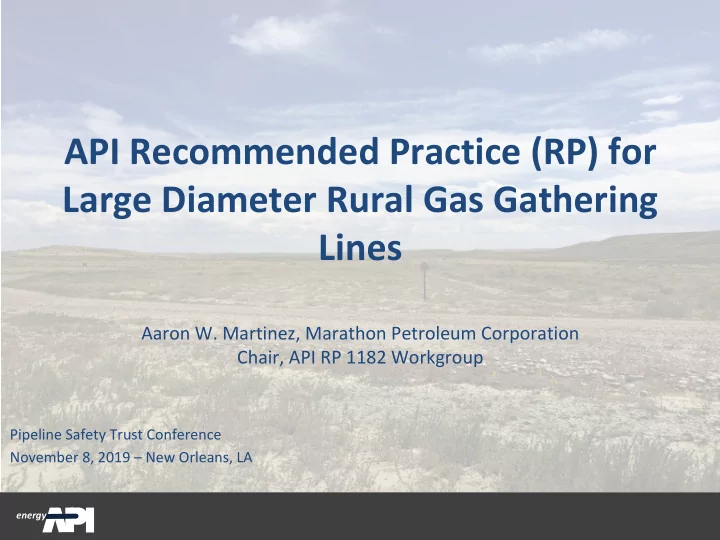

API Recommended Practice (RP) for Large Diameter Rural Gas Gathering Lines Aaron W. Martinez, Marathon Petroleum Corporation Chair, API RP 1182 Workgroup Pipeline Safety Trust Conference November 8, 2019 – New Orleans, LA energy
Background • Increase in US natural gas production, especially unconventional production in shale regions • Increased production resulting in larger diameter, larger pressure gathering lines • Most of these new lines are Class 1 Rural Gathering lines, not subject to federal standards Image Source: Department of Energy. https://www.energy.gov/fe/shale-gas-101#pro • Regulators and industry share a common goal of safe and reliable pipeline transportation energy
What is Gathering? Electric Generation Plant Gas Processing Local Distribution Facility Company (City Gates) Customers Oil / Gas Wells Distribution Transmission Production Gathering energy
What is a Class Location? Current Class Locations Class 1 Class 4 Rural Class 2 Class 3 Site Class 3 Gathering 660 ft. Class Location Unit 300 ft. Class 3 Site Not subject to (Type A or B Gathering Lines) federal Subject to federal standards standards energy
What are we doing about it? • API initiated creation of Recommended Practice (RP) 1182 – Large Diameter Rural Gas Gathering Lines • Initial meeting in January 2018 • Almost 100 participants • Industry • Regulators • Public advocacy groups • Uses existing, proven concepts to evaluate potential public risk • Diameter + Operating Pressure • Class Location Analysis + Potential Impact Radius • Possible framework for future regulation • Final draft up for ballot now! energy
What does it say? • Applies to rural gas gathering lines greater than 12.75 inches in diameter • Two categories: • Type C - Higher pressure (with some exceptions) • Type D – Lower pressure (and those excepted from Type C) • Requirements include: • Design, construction, and testing (new pipelines) • Maximum allowable operating pressure (MAOP) • Damage prevention and line marking • Emergency response & notifications • Repair • Security • Leak surveys • Corrosion control • Public awareness • Record Keeping energy
How do I comment? http://ballots.api.org/login.aspx energy
Next Steps • Resolve stakeholder comments and finalize • Operators lead by example • Continue to gather and analyze data • Plan, Do, Check, Act energy
Recommend
More recommend